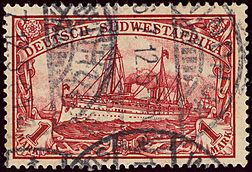South West African mark facts for kids
Quick facts for kids South West African mark |
|||
|---|---|---|---|
|
|||
| User(s) | South West Africa | ||
| Subunit | |||
| 1⁄100 | Pfennig | ||
| Coins | |||
| Freq. used | 10, 25, 50 Pfennig | ||
| Banknotes | |||
| Freq. used | 1, 2, and 3 Mark | ||
The South West African mark was a special money used for a short time in a place called South West Africa. This happened between 1916 and 1918. It was used after the old German money, the German South West African mark, was no longer in use. Then, the South African pound became the new money in 1918.
Contents
What Was the South West African Mark?
The South West African mark was a temporary currency. It helped people buy and sell things during a time of change. This money was needed because the old German money was gone. The new South African money had not yet arrived.
Who Made This Money?
Many of the notes for this money were made by local businesses. A well-known place that printed these notes was the Swakopmund Bookshop. They made different values of notes.
What Did the Notes Look Like?
The Swakopmund Bookshop printed notes in different amounts.
- They made small notes for 10, 25, and 50 Pfennig.
- They also made larger notes for 1, 2, and 3 Mark.
These notes helped people buy everyday items.
See Also
- South West African banknote issuers
- Banknotes of the Swakopmund Bookshop




